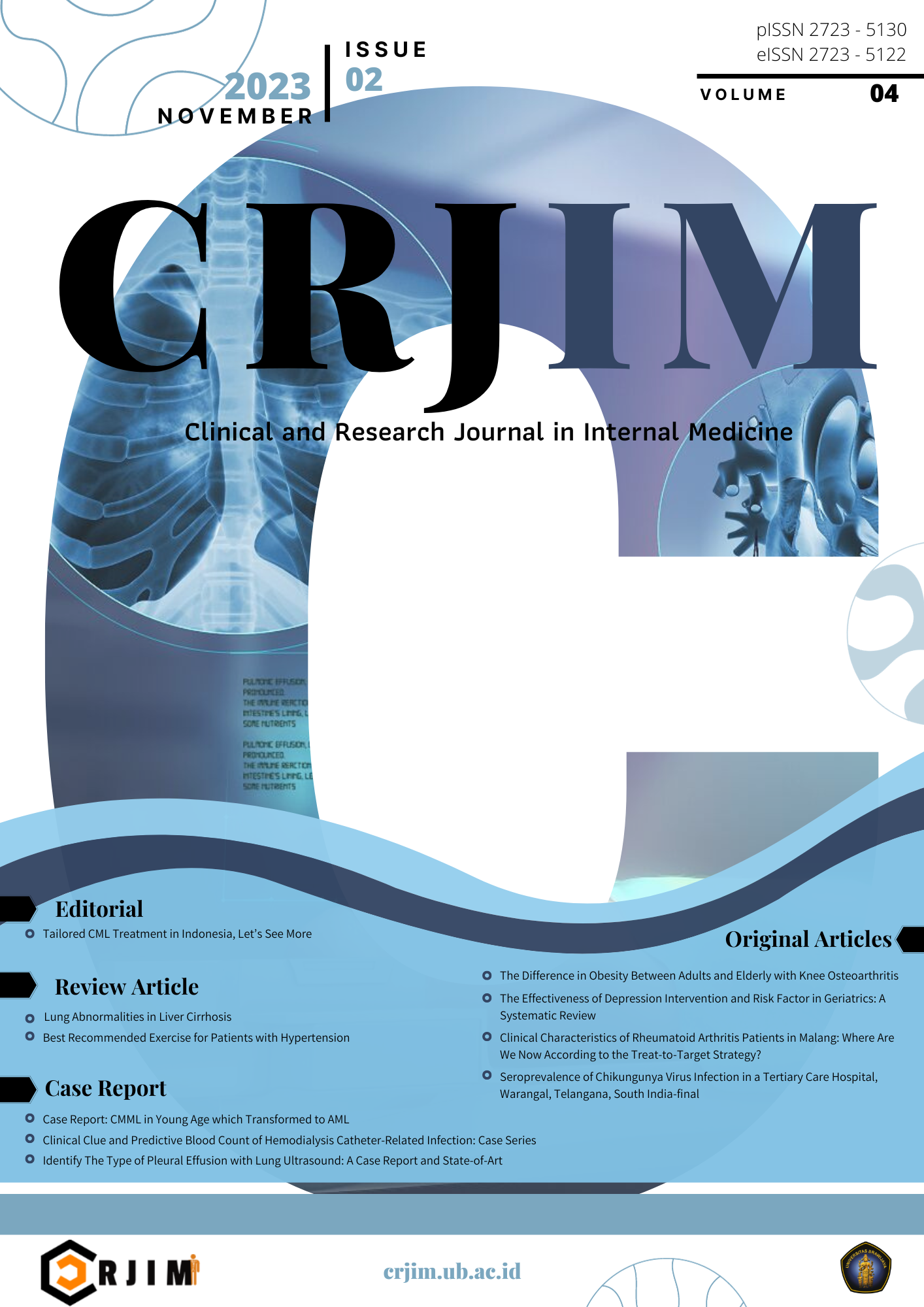Comparison of Diagnostic Value between Point of Care Testing (POCT) and Standardize HbA1c Testing in Primary Health Care
DOI:
https://doi.org/10.21776/ub.crjim.2020.001.02.2Keywords:
diabetes mellitus, HbA1c, High Performance Liquid Chromatography (HPLC), Point of Care Testing (POCT)Abstract
Diabetes Mellitus is one of the biggest health problems. HbA1c is used to diagnose, to monitor treatment and treatment adjustment. High Performance Liquid Chromatography (HPLC) and electron spray mass spectrometry are recommended to measure HbA1c. But both methods need expensive cost, facility, and potentially increase health cost burden. HbA1c measurement using Point of Care Testing (POCT) is developed in Indonesia. POCT is more comfortable, has lower cost and easily brought to primary health care. Aim: to assess the clinical efficacy of POCT compared with a standard examination by HPLC. Methods: It is a cross-sectional observational study conducted at a first-level health facility (FKTP) in Malang. The subject population was patients who went to an outpatient unit in FKTP with inclusion criteria aged 20-75 years, were participants in the chronic disease management program (PROLANIS), both diabetes and non-diabetes. Results: Three hundred and thirty eight subjects were participated in this study. Five subjects were excluded because the presence of anemia. We used Wilcoxon test to compare HbA1c level between two methods and Rank Spearman correlation test to find correlation between two methods. This study showed measurement HbA1c level using POCT method had good accuracy (>80%). Other than diagnosis value, increased utilization of POCT HbA1c might also be caused by its portability and patient’s comfort. Conclusions: This study showed a strong correlation (R=0.016) between POCT HbA1c and standardized measurement. POCT HbA1c also showed good accuracy in all HbA1c groups.
References
Cho NH, Whiting D, Forouhi N, Guariguata L, Hambleton I, Li R, et al. IDF Diabetes Atlas In: Federation ID, editor. 2015.
Soendoro T. Riset kesehatan dasar (RISKESDAS) 2007. In: Health Mo, editor. Jakarta: Badan Penelitian dan Pengembangan Kesehatan Departemen Kesehatan Republik Indonesia. 2008.
Cefalu WT. American diabetes association standards of medical care in diabetes 2017. Diabetes Care. 2017;40(Supplement 1).
Soelistijo SA. Konsensus pengelolaan dan pencegahan diabetes melitus di Indonesia 2015. 2015.
Al-Ansary L, Farmer A, Hirst J, Roberts N, Glasziou P, Perera R, et al. Point-of-care testing for Hb A1c in the management of diabetes: a systematic review and meta-analysis. Clinical chemistry. 2011;57(4):568-76. [doi: 10.1373/clinchem.2010.157586]
Bubner TK, Laurence CO, Gialamas A, Yelland LN, Ryan P, Willson KJ, et al. Effectiveness of point-of-care testing for therapeutic control of chronic conditions: results from the PoCT in General Practice Trial. The Medical journal of Australia. 2009;190(11):624-6. [PMID: 19485840]
Kahn CR, Weir GC, King GL, Smith RJ. Joslin's Diabetes Mellitus. 2000.
Camargo JL, Gross JL. [Glycohemoglobin (GHb): clinical and analytical aspects]. Arq Bras Endocrinol Metabol. 2004;48(4):451-63. [doi: 10.1590/s0004-27302004000400005]
Lenters-Westra E, Schindhelm RK, Bilo HJ, Slingerland RJ. Haemoglobin A1c: historical overview and current concepts. Diabetes research and clinical practice. 2013;99(2):75-84. [doi: 10.1016/j.diabres.2012.10.007 ]
Penttila I, Penttila K, Holm P, Laitinen H, Ranta P, Torronen J, et al. Methods, units and quality requirements for the analysis of haemoglobin A1c in diabetes mellitus. World journal of methodology. 2016;6(2):133-42. [doi: 10.5662/wjm.v6.i2.133]
Ejilemele A, Unabia J, Ju H, Petersen JR. A1c Gear: laboratory quality HbA1c measurement at the point of care. Clinica chimica acta; international journal of clinical chemistry. 2015; 445:139-42.
Knaebel J, Irvin BR, Xie CZ. Accuracy and clinical utility of a point-of-care HbA1c testing device. Postgraduate medicine. 2013;125(3):91-8.
Leal S, Soto-Rowen M. Usefulness of point-of-care testing in the treatment of diabetes in an underserved population. Journal of diabetesscience and technology. 2009;3(4):672-6. [doi: 10.1177/193229680900300409]
Spaeth BA, Shephard MD, Schatz S. Point-of-care testing for haemoglobin A1c in remote Australian Indigenous communities improves timeliness of diabetes care. Rural and remote health. 2014;14(4):2849. [PMID: 25359698]
Manley SE, Hikin LJ, Round RA, Manning PW, Luzio SD, Dunseath GJ, et al. Comparison of IFCC-calibrated HbA(1c) from laboratory and point-of-care testing systems. Diabetes research and clinical practice. 2014;105(3):364-72. [PMID: 24985893]
The use of POCT HbA1c devices in the NHS Diabetes Prevention Programme: Recommendations from an expert working group commissioned by NHS England. 2014. [Corpus ID: 56966705]
Sanchez-Mora C, M SR-O, Fernandez-Riejos P, Mateo J, Polo-Padillo J, Goberna R, et al. Evaluation of two HbA1c point-of-care analyzers. Clinical chemistry and laboratory medicine. 2011;49(4):653-7. [PMID: 21323623]
Shephard MD, Mazzachi BC, Shephard AK, McLaughlin KJ, Denner B, Barnes G. The impact of point-of-care testing on diabetes services along Victoria's Mallee Track: results of a community-based diabetes risk assessment and management program. Rural and remote health. 2005;5(3):371. [PMID: 16026194]
Wiwanitkit V. Hemoglobin A1C determination by point-of-care testing: its correlation to standard method. Diabetes & metabolic syndrome. 2012;6(2):110-1. [ doi:10.1016/j.dsx.2012.08.014]
Sicard DA, Taylor JR. Comparison of point-of-care HbA1c test versus standardized laboratory testing. The Annals of pharmacotherapy. 2005;39(6):1024-8.[doi: 10.1345/aph.1E504]
El-Osta A, Woringer M, Pizzo E, Verhoef T, Dickie C, Ni MZ, et al. Does use of point-of-care testing improve cost-effectiveness of the NHS Health Check programme in the primary care setting? A cost-minimisation analysis. BMJ open. 2017;7(8): e015494. [doi: 10.1136/bmjopen-2016-015494 ]
Crocker B, Lewandrowski EL, Lewandrowski N, Gregory K, Lewandrowski K. Patient satisfaction with point-of-care laboratory testing: report of a quality improvement program in an ambulatory practice of an academic medical center. Clinica chimica acta; international journal of clinical chemistry. 2013; 424:8-11.[doi: 10.1016/j.cca.2013.04.025 ]



















